Barra
Located in the encounter of the Atlantic Ocean with Todos os Santos Bay, Barra is the most advanced geographical point of the city on the sea. In the place where Fort Santo Antônio da Barra was built, navigator Américo Vespúcio placed the mark of Portuguese ownership, in 1501. In Porto of Barra, the first donee of the Captaincy of Bahia, Francisco Pereira Coutinho, disembarked, in 1535, and Captain Tomé de Souza founded Salvador in 1549. The monuments of this area, such as Forts Santa Maria and São Diogo, and churches Santo Antônio da Barra, Nossa Senhora da Graça and Nossa Senhora da Vitória, are part of the city‘s initial history.
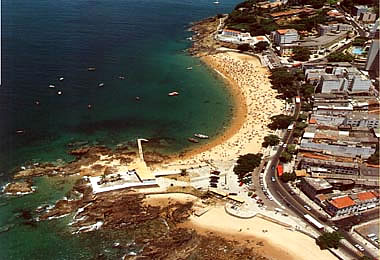
Fort Santo Antônio da Barra
First fort built in the city, it had the function of hindering the enemies entrance in Todos os Santos Bay. Initiated in 1582, it got the shape of an irregular polygon with ten sides, six salient and four re-entering angles; its current dimensions, however, just came about in the 17th century. The first wooden lighthouse, which functioned with whale oil, was made in 1696 and it indicated the entrance of the bay, alerting to the dangers of the coral reef or sandbank of Santo Antônio – the current iron lighthouse, working with electricity, was built in 1836. In the fort, there are a restaurant, a bar and the Nautical Museum, with exhibitions of old maps, navigation equipment, models of vessels, artillery pieces and remains of shipwrecks that happened in Barra, mainly Galeão Sacramento‘s.
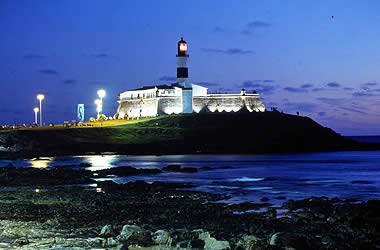
Porto da Barra
With the whole coast almost surrounded by reefs, the city has in Porto da Barra the only place where the landing of small boats in safety is possible.
With the shape of a small bay, the port was chosen by donee Francisco Pereira Coutinho to found the Villa of the Captaincy of Bahia. Known as Pereira’s Villa, it received the ships that made trade with the native commanded by Diogo Álvares “Caramuru” in the first half f the 16th century. There, general governor Tomé de Souza (1549), and the soldiers of Companhia das Índias Ocidentais that invaded the city in 1624 also landed off.
A commemorative mark, built in 1949, points out the place where Tomé de Souza landed off.
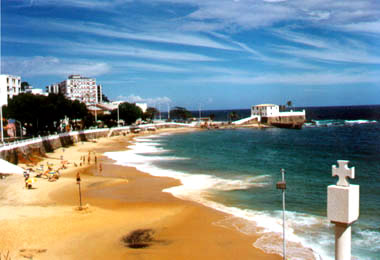
Fort Santa Maria
Built to protect Porto da Barra from the invaders, crossing fires with Fort São Diogo, the fort already existed when Companhia das Índias Ocidentais tried to occupy Salvador for the second time, in 1638.
With seven sides, four salient and three re-entering angles, in design is of Italian type from the end of the 18th century.
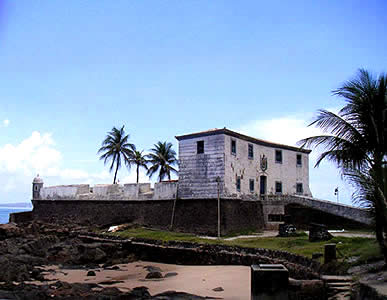
Fort São Diogo
Crossing fires with Fort Santa Maria and also with the function of impeding the disembarkation of invaders in the only natural port of the city, this fortification also existed in 1638 when the Dutchmen invaded Salvador for the second time. Embedded in the base of Santo Antonio‘s Hill, its main room exhibits a video on the System of Colonial Defense of the City of Salvador daily and, at noon, the fort discharges a cannon shot as it happened formerly.
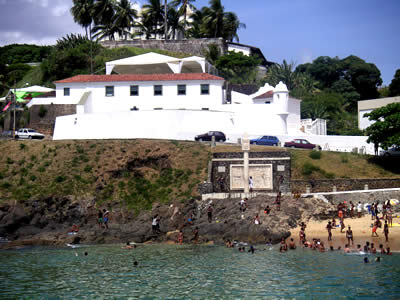
Santo Antônio da Barra Church
Located on a hill, with a dominant view over Barra and a great extension of Todos os Santos Bay, this temple was built between 1595 and 1600. Its frontispiece presents a high classic front in a triangular way accompanied by two towers in pyramid, covered by tiles.
Church and Abbey of Nossa Senhora da Graça
The primitive wall chapel, covered with straw, in praise of Nossa Senhora da Graça, was built in 1535, by order of Catarina Álvares “Paraguaçú”, “Caramuru‘ s wife. The current church and its abbey were built in 1645 by the Benedictine, heirs of the lands of the family Álvares. Considered Catarina‘s first temple – whose body was buried in its interior in 1583 -, the Church of Nossa Senhora da Graça is the oldest in Salvador.
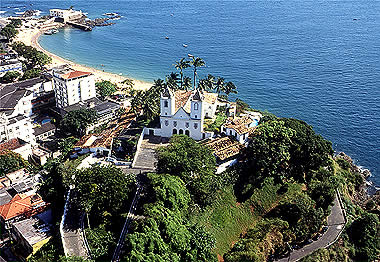
Nossa Senhora da Vitória Church
This temple disputes with the Church of Nossa Senhora da Graça over the title of the first church built in Salvador. Re-built in 1666, with frontispiece facing the sea, it was totally reformed in 1809, when an inversion in the positions of the altar and the entrance of the church happened. In 1910, the new frontispiece got a decoration that has lasted until today.
Notes:
(*) Américo Vespúcio – This Genovese navigator that gave name to the American continent, was hired, in 1501, by the king D. Manuel from Portugal to explore and to map Brazil‘s coast. Vespúcio was the first European to enter Todos os Santos Bay and he landed at Porto da Barra, where he stayed for two weeks.
(*) Francisco Pereira Coutinho – The arrival of the Captaincy of All Saints Bay’‘ s donee, in the end of 1535, was not well received by the natives. They reacted against the invasion of their lands by the Portuguese, since they also tried to put them under slavery. Unqualified for social issues and having an arrogant temper, the donee saw his enterprise fail, so he decided to kidnap Diogo “Caramuru”- who, together with his wife Catarina “Paraguaçú”, led the natives - and fled to the Captaincy of Porto Seguro. When he tried to come back and bring "Caramuru" as a hostage, in 1548, he was ambushed in the coast of the Island of Itaparica and killed by the natives.
(*) Diogo Álvares "Caramuru" - Castaway of a French ship that sank in the reefs of the coast of Bahia in 1509, the Portuguese was helped by a native tribe and married the chief‘s daughter. White, found naked, starving, tired and camouflaged with sargasso, he was initially mocked by the natives, who called him "Caramuru" - a fish similar to the moray that hides in the reefs. However, he was saved from the sacrifice of death and of being devoured by the tribe. His knowledge about the interest of the Europeans in the lands of Brazil, his ability in the treatment with the natives and his diplomacy ended up transforming him into the most important illustration of the first half of the 16th century in Bahia. "Caramuru" intermediated the businesses and facilitated the contacts among navigators, European and native merchants, besides helping in the provisioning and recovery of the embarkations that proceeded from the Brazilian coast heading towards Rio da Prata and to the East, in the route of the spices.
(*) Catarina Álvares "Paraguaçú" - chief Taparica‘s daughter, from the tribe that found the castaway "Caramuru", she was a leader of her people. Her curiosity brought her forth to interrogate the Europeans that were captured by the tribe. She became to main companion of Diogo Álvares "Caramuru", whom she soon married officially in France after being baptized at the Catholic Church in 1527. Her devotion to Jesus‘ Mother led to the construction of the Church of Graça and her territorial inheritance was delegated to the Ordem Beneditina of Bahia. She died in 1583.
(*) Tomé de Souza - Considered a good administrator and hero of the Portuguese conquests in India, Captain Tomé de Souza received from King D. João III the mission of founding the first city of the American continent. His government in the capital of Brazil lasted from 1549 to 1552 and it was decisive for the success of the first Portuguese lunge in the new world.
